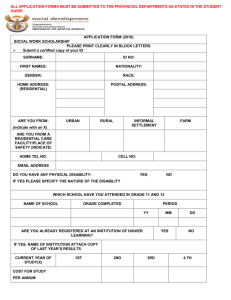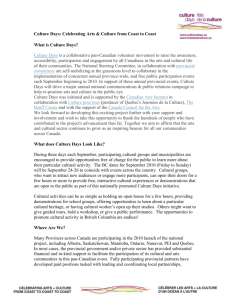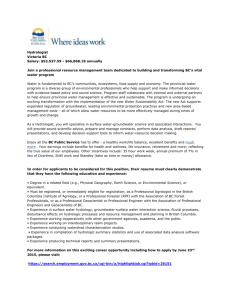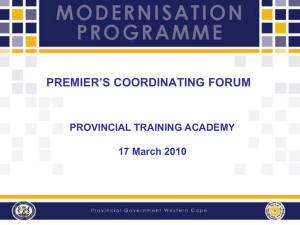File - Arcuric Acid
advertisement
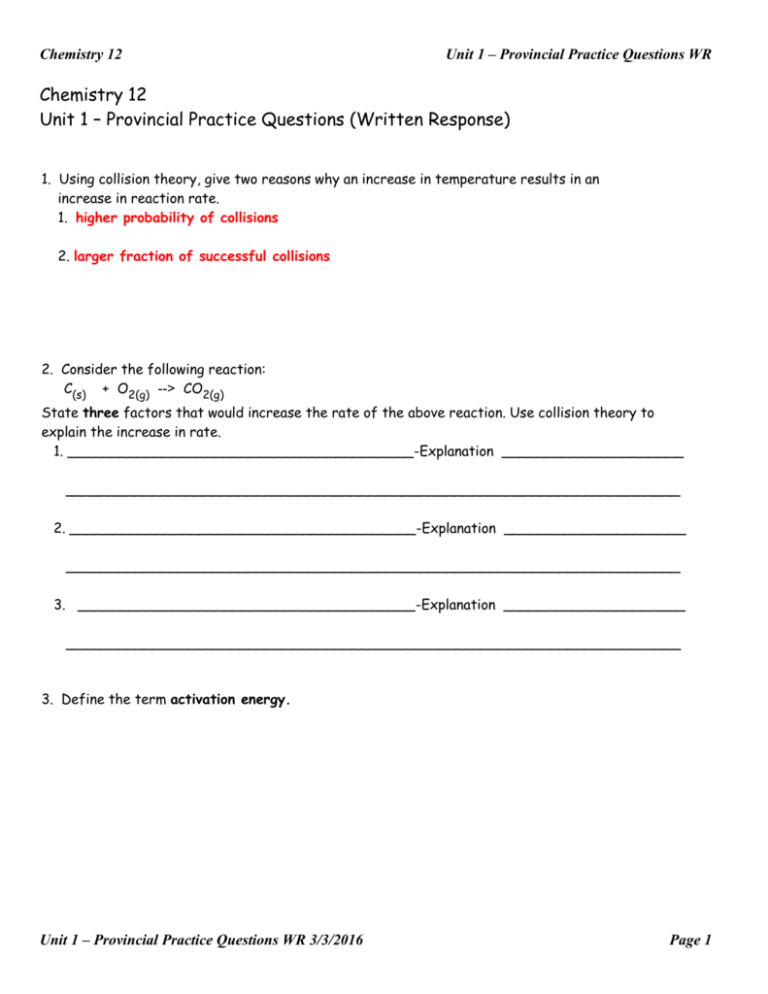
Chemistry 12 Unit 1 – Provincial Practice Questions WR Chemistry 12 Unit 1 – Provincial Practice Questions (Written Response) 1. Using collision theory, give two reasons why an increase in temperature results in an increase in reaction rate. 1. higher probability of collisions 2. larger fraction of successful collisions 2. Consider the following reaction: C(s) + O2(g) --> CO2(g) State three factors that would increase the rate of the above reaction. Use collision theory to explain the increase in rate. 1. ________________________________________-Explanation _____________________ _______________________________________________________________________ 2. ________________________________________-Explanation _____________________ _______________________________________________________________________ 3. _______________________________________-Explanation _____________________ _______________________________________________________________________ 3. Define the term activation energy. Unit 1 – Provincial Practice Questions WR 3/3/2016 Page 1 Unit 1 – Provincial Practice Questions WR Chemistry 12 4. Consider the following overall reaction: 2NO + 2H2 --> 2H2O + N2 a) Explain why the reaction is likely to involve more than one step. b) A proposed mechanism for the reaction is: Step 1: NO + H2 N + H2O Step 2: NO + N N2O Step 3: ??? Write the equation for Step 3. _______________________________________ c) Give the formula for the activated complex in Step 1 _______________________ d) Give the formula for the activated complex in Step 3 _______________________ e) Identify two reaction intermediates ___________ and _____________ 5. Consider the decomposition of ammonia: 2 NH3(g) --> N2(g) + 3 H2(g) When 1.0 mole NH3 reacts, 46 kJ of energy is absorbed. Rewrite the equation for this reaction, including the value of the heat term. _______________________________________________________________________ Unit 1 – Provincial Practice Questions WR 3/3/2016 Page 2 Unit 1 – Provincial Practice Questions WR Chemistry 12 6. Consider the following reaction mechanism: Step 1: ClO2(g) + F2(g) --> FClO2(g) + F(g) Step 2: F(g) + ClO2(g) --> FClO2(g) (slow) (fast) a) Write the equation for the overall reaction. ________________________________________ b) Identify a reaction intermediate. ____________________________________________ c) If some F2 was introduced into the reaction chamber, would the overall reaction rate increase? _________________Explain why or why not. _______________________________________ ____________________________________________________________________________ d) If some F was introduced into the reaction chamber, would the overall reaction rate increase? _________________Explain why or why not. _______________________________________ ___________________________________________________________________________ e) Write the formula for the activated complex in Step 1. _________________________________ f) Is there a catalyst in this mechanism? . ______________________________________ g) The rate determining step is step _________ 7. A strip of magnesium was cut into 4 pieces, each of length 1.0 cm and mass of 0.00972 g. Each piece was placed into a test tube containing 5.0 mL of different concentrations of HCl. The time required for each piece of magnesium to be completely consumed was recorded: Trial [HCl](M) Time (s) 1 0.50 200 2 1.0 38 3 3.0 12 4 6.0 6 a) Calculate the rate of reaction for magnesium in 3.0 M HCl. b) How does the [HCl] affect the reaction rate? Unit 1 – Provincial Practice Questions WR 3/3/2016 Page 3 Chemistry 12 c) Give a reason for your answer for (b) using collision theory Unit 1 – Provincial Practice Questions WR 8. Consider the following potential energy diagram for a reversible reaction: a) Determine the activation energy for the forward reaction. ______________ b) Determine H for the forward reaction _____________ c) Determine the activation energy for the reverse reaction. ________________ d) Which reaction, the forward or the reverse would have the faster rate? ________ Explain your answer The forward rx has the lower activation energy so it will have the faster rate e) A catalyst can be added to this reaction. The catalyzed mechanism has two steps. The first step is fast and the second step is slow. On the graph above, show the curve for the catalyzed reaction with a dotted line. 9. A student wishes to monitor the rate of the following reaction: Cu(s) + 4HNO3(aq) --> Cu(NO3)2 (aq) + 2NO2(g) + 2H2O(l) + heat colourless blue brown Identify 3 different properties that could be used to monitor the rate of the reaction. Describe and explain the changes that would occur. Property 1 ________________________________. Changes that occur as the reaction proceeds. ____________________________________________________________ Property 2 ________________________________. Changes that occur as the reaction proceeds. ____________________________________________________________ Unit 1 – Provincial Practice Questions WR 3/3/2016 Page 4 Chemistry 12 Unit 1 – Provincial Practice Questions WR Property 3________________________________. Changes that occur as the reaction proceeds. ____________________________________________________________ 10. Consider the following reaction: 2Fe(s) + 6HCl(aq) --> 2FeCl3(aq) + 3H2(g) A 0.037 g sample of Fe reacts completely with HCl in 18.3 s. Calculate the volume of H2(g) produced in 4.0 minutes. Show all your work. Assume the gas is at STP. 11. Consider the reaction: 2H2O(l) --> 2H2(g) + O2(g) The rate of production of O2 is 2.3 x 10-2 mol/s . How many seconds will it take to decompose 85.0 g of H2O? Show all of your work in a clear manner. 12. Define the term heterogeneous reaction. _________________________________ ________________________________________________________________ What factor affects the rate of only heterogeneous reactions? _________________ Unit 1 – Provincial Practice Questions WR 3/3/2016 Page 5 Chemistry 12 Unit 1 – Provincial Practice Questions WR 13. The release of O2(g) resulting from the decomposition of bleach was measured in two different experiments. Data was collected and the following graph was drawn: a) Calculate the average rate of reaction for each experiment. Rate of Experiment 1: Rate of Experiment 2: b) Identify a variable from Experiment 1 and how it was changed to produce the different reaction rate for Experiment 2. Explain using collision theory. Either the concentration of bleach or the temperature could be decreased. Both would decrease the number of possible collisions, and a decrease in temperature would decrease the fraction of successful collisions. Unit 1 – Provincial Practice Questions WR 3/3/2016 Page 6

